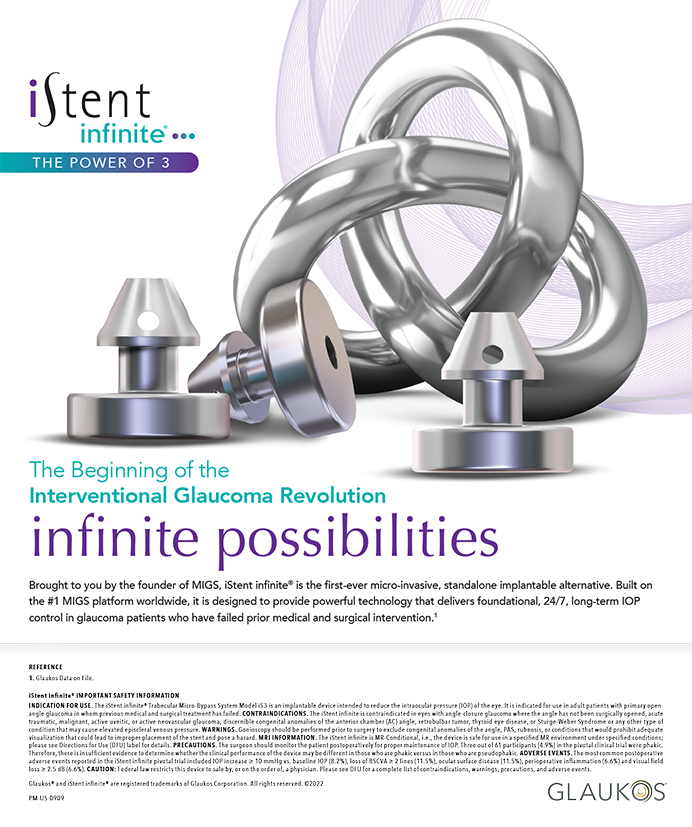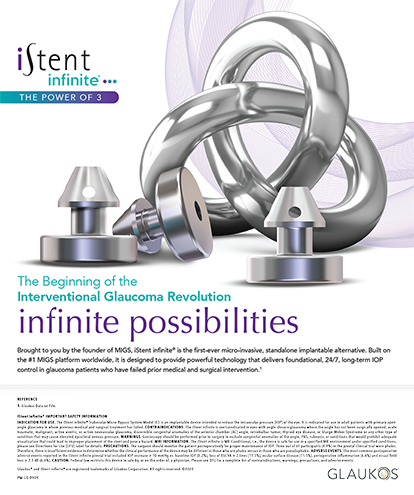Ophthalmologists are well accustomed to hearing patients complain about chronic dry eye. The disease, also known as keratoconjunctivitis sicca, is one of the most common reasons people visit eye care professionals,1 and it affects more than 3.2 million Americans2 with decreased tear production and an altered tear composition that can no longer support the ocular surface. If left untreated, chronic dry eye can lead to an increased risk of infection and visual impairment.2
LONG-TERM SAFETY EVALUATIONExtended Study
The initial reports of the phase III clinical trials of cyclosporine 0.05% and 0.1% ophthalmic emulsions showed that it was a safe and effective therapy.3 Study patients achieved an improvement in tear production, as measured by the Schirmer test, and in corneal fluorescein staining when compared with the vehicle.
In order to evaluate the long-term safety of cyclosporine, the ophthalmic cyclosporine phase III clinical trials were extended4 and designed to evaluate cyclosporine 0.1% ophthalmic emulsion b.i.d. for 12 to 36 months in 412 patients with moderate-to-severe keratoconjunctivitis sicca who were previously enrolled in one of two 12-month cyclosporine studies.3 Patients were eligible for the extended study if they enrolled within 1 week of completing one of the earlier trials.
Main Outcome Measures
Efficacy was evaluated only during the first 12-month extension trial. Because of the participants' prior cyclosporine treatment from the original phase III trials, additional improvement was expected to be modest.
During the first year, my colleagues and I measured efficacy by corneal staining and Schirmer tests, along with symptom-severity assessments and other subjective measures. The symptoms we evaluated included dryness, pain, itching, blurred vision, a sandy/gritty feeling, burning/stinging, and sensitivity to light. The symptom scores at 1 year were unchanged from the baseline indication, except for a 0.1-unit decrease in blurred vision and the Ocular Surface Disease Index, which decreased by 0.014 units.
Patients also completed a survey during the second 12-month extension. Biomicroscopy and visual acuity examinations, IOP measurements, and adverse effects queries occurred at 6-month intervals.
Results
Early in my use of cyclosporine for dry eye patients, it became evident that this therapy was successful where traditional treatments failed. As with any new therapy, I wanted to ensure that I was prescribing something for my patients that was safe as well as efficacious.
The results from the extension trial provide an additional margin of safety for the commercially available cyclosporine 0.05% ophthalmic emulsion. Paralleling what I see in my patients who use Restasis (Allergan, Inc., Irvine, CA), the extension study found cyclosporine to be safe and well tolerated, even with the cyclosporine concentration being more than twice that in Restasis. Moreover, the incidence of adverse events was low in each group and no serious treatment-related adverse events were reported. More than 78% of patients instilled cyclosporine 0.1% for at least 12 months (mean = 19.8 months).
Patients surveyed in the second year of the extension trial for cyclosporine 0.1% reported improved symptoms with the treatment. In more than half of patients (62.5%), symptoms began to resolve in the first 3 months of the study treatment. When asked if they would continue taking cyclosporine 0.1%, 95.2% said they would, and 97.9% said they would recommend it to other patients.
The daily use of artificial tears decreased with cyclosporine treatment from 7.6 times per day before the start of treatment during the original clinical trials, to 3.8 times per day at the end of the first 12-month period. This finding demonstrates that, with continued use of cyclosporine, most patients will use artificial tears less frequently. Adverse events in the study were similar to previous phase III study results; most were mild-to-moderate, and burning/stinging after installation occurred most frequently.
CONCLUSION
Restasis has become the most potent weapon in my armamentarium for patients with chronic dry eye. I have found that the majority of them experience improvements in irritation symptoms, achieve better visual function, and develop a healthier ocular surface.
Because of my personal success with Restasis, I am pleased that, in the extension trial, cyclosporine 0.1% b.i.d. continued to provide efficacious treatment for dry eye patients. Study results show it is safe and well tolerated for up to 3 years.
Because the concentration of cyclosporine used in this trial was twice that of Restasis (0.1% versus 0.05%, respectively), the study concentration should be as safe and well tolerated without associated systemic side effects. Moreover, the clinical evidence from this extension study confirms that Restasis could be a first-line prescriptive treatment for dry eye patients. It is a valuable therapy that ophthalmologists now know is safe for long-term use.
Laurie Barber, MD, is Professor of Ophthalmology at the University of Arkansas Medical School in Little Rock. She states that she serves on advisory boards for Allergan and Inspire, and receives research support from Allergan Inc., Inspire Pharmaceuticals, Inc., Alcon Laboratories, Inc., and Otsuka Pharmaceutical Co. Ltd. Dr. Barber may be reached at (501) 526-6000 x1203; barberlauried@uams.edu.
1. The 2002 Gallup Study of Dry Eye Sufferers, October 2002.2. Schaumberg DA, Sullivan DA, Buring JE, et al. Prevalence of dry eye syndrome among US women. Am J Ophthalmol. 2003;136:318-326.
3. Sall K, Stevenson OD, Mundorf TK, Reis BL. The CsA phase 3 study group. Two multicenter, randomized studies of the efficacy and safety of cyclosporine ophthalmic emulsion in moderate to severe dry eye disease. Ophthalmology. 2000;107:631-639.
4. Barber L, Pflugfelder S, Tauber J, Foulks G. Phase 3 safety evaluation of cyclosporine 0.1% ophthalmic emulsion instilled twice daily for up to 3 years. Paper presented at: The annual AAO/ASOA meeting; October 24, 2004; New Orleans, LA.


